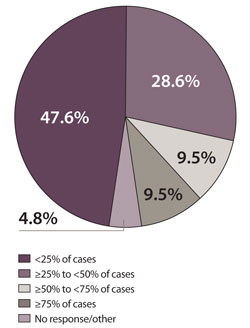The OSNE300 Survey
The OSNE300 Survey is a group of 300 European surgeons regularly polled for their opinions on hot topics in ophthalmology. The surveys are sent monthly, 10 times a year, to those on the list. If you do not receive the survey and would like to be included, please contact Managing Editor Erin L. Boyle at eboyle@slackinc.com.
Click Here to Manage Email Alerts
 |
Which tests do you routinely order for patients with diabetic macular edema?

 Paolo Lanzetta |
Although fluorescein angiography (FA) is still a mandatory exam for diagnosing and characterizing diabetic macular edema (DME), optical coherence tomography (OCT) is progressively replacing FA in monitoring the disease and assisting physicians in retreatment strategies. Therefore, practically speaking, a patient with DME undergoes FA — which is an invasive procedure with potential severe side effects — at the time of initial diagnosis, whereas during the subsequent follow-up time, the efficacy of the treatment is mostly based on the OCT patterns, namely the presence or absence of intraretinal and subretinal fluid. Moreover, spectral domain OCT has now replaced time domain OCT, allowing for much more information, such as the volume of the fluid including retinal pseudocysts, the integrity of the photoreceptors and external limiting membrane. As a result re-treatment algorithms based on morphologic changes as evaluated with OCT are still far from being validated and fully precise. However, the number of FAs performed in patients with DME is continuously decreasing.
— Paolo Lanzetta, MD
OSN Europe Edition
Board Member, Udine, Italy
Disclosure: Dr. Lanzetta is a consultant for
Alimera, Allergan, Bayer, Novartis, Roche and has a patent for Iridex.
 |
In what percentage of cases do you use a macular laser at some point during the course of DME treatment?
![]()

Recent data on the treatment of DME suggest that, at least in the mid-term, anti-VEGF agents are more efficacious than laser photocoagulation and that combining laser treatment with anti-VEGFs does not reduce the number of injections needed or improve visual acuity outcomes. So the very question is not whether laser photocoagulation is still used at some point during the course of DME treatment but rather which is the first-line therapy. Although we need more data on the long-term efficacy, intravitreal anti-VEGFs should be considered the treatment of first choice. Obviously, in the case of a very limited focal edema, laser photocoagulation is still worthy but cases with diffuse and thickened central retina should be addressed with intravitreal anti-VEGF injections. Although, as said, adjunctive grid laser does not appear to be of relevant benefit at this time, I still tend to add laser photocoagulation once the retina has flattened after anti-VEGF administration. Treating a DME when retinal thickness has reduced allows for less invasive thermal photocoagulation by using lower energies either with micropulse laser or by shortening exposure time in a PASCAL-like continuous mode.
— Paolo Lanzetta, MD
OSN Europe Edition
Board Member, Udine, Italy
Disclosure: Dr. Lanzetta is a consultant for
Alimera, Allergan, Bayer, Novartis, Roche and has a patent for Iridex.
![]()

OCT is becoming a very useful tool in detection and management of diabetic macular edema. Although fundus fluorescein angiography (FFA) still plays a major role in the diagnosis of macular edema, OCT became everyone’s test in diabetic patients for its many advantages. This non-invasive technology provides, in both mydriatic and non-mydriatic pupils, immediate information about the retinal layers and thickness and reflects the efficacy of the treatment method that is applied.
I usually perform OCT and FFA in the first visit for all diabetic patients with macular problems, then OCT at almost every visit.
We all know that laser macular treatment is a conventional method well known for its wide application in diabetic patients, but lately the use of intravitreal injection of anti-VEGF and/or triamcinolone acetate has become the trend in controlling the problem of macular edema in most cases, and we could say that it has become the first-line treatment. After the edema is well controlled, the laser treatment is done in almost all cases.
In cases with difficult or resistant response, there are still benefits from vitrectomy and intracavitary injections, which later on would be followed by a laser treatment to complete the treatment protocol initiated.
Today there is no case of diabetic macular edema that will not need an OCT before the treatment is applied or during the follow-up, and at sometime during the course of the disease, a laser macular treatment will certainly be needed.
— A. Galal, MD, Msc, MBA, PhD
Anterior and
posterior segment surgery, Oftavist Ophthalmology Clinics and Hospitals,
Spain
Disclosure: Dr. Galal has no relevant financial disclosures.

